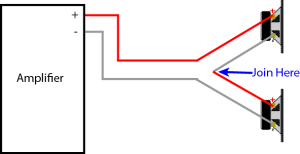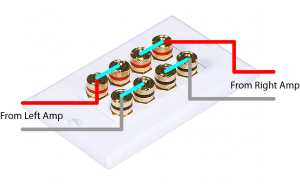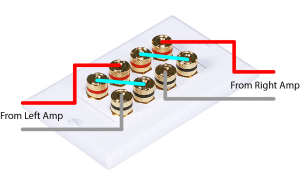In this article we look at how and when to connect 2 speakers in parallel or series. Both the theory and practical points on how to connect 2 speakers are discussed. Connecting 2 speakers in parallel or series to your amplifier is useful when:
- you don’t need to turn each speaker on or off individually, or
- you don’t need to have separate volume controls for each speaker.
If you need to turn each speaker on or off individually or have separate volume controls, you may need a speaker selector switch. In this case you should read the articles on connecting multiple speakers, wiring 4 speakers, and/or my summary of speaker selector switches.
Many people get confused when we talk about a stereo amplifier. A stereo amp simply has two amplifiers built into the one box. We are not talking about connecting two speakers to a stereo amp, as that simply involves connecting one speaker to each amplifier (left and right). There are many cases when you want to connect four speakers to a stereo amp, that is, to connect 2 speakers to each amplifier – or four speakers in total. For the rest of this article, when we talk about an amplifier, we are talking about either the left or right amplifier only.
You may want to connect 2 speakers to one amplifier without individual switching or volume controls if you:
- have a large living area with four ceiling speakers, or
- want to cover a large backyard with four speakers, or
- have any situation where two speakers are not enough.
The are two basic ways of connecting two speakers together – either in series or parallel.
Should 2 speakers be connected in Series or Parallel?
Whether 2 speakers connected to one amplifier should be in series or parallel mostly depends on the impedance of the speakers.
The impedance of the speakers should be written on the back of the speaker or speaker box. The impedance of a speaker is normally 4 ohms, 6 ohms or 8 ohms. If it isn’t written on the back of the speaker, check any paper work that might have come with the speaker, or look up the specifications on the web. The Ω symbol is often used instead of writing “ohms”.
If both speakers are 8 ohms or more, then the speakers can normally be wired in parallel.
If the speakers are less than 8 ohms, then to be safe, you should wire them in series.
Connect 2 Speakers in Parallel
To calculate the total load impedance of speakers in parallel, see my Speakers in Parallel Calculator.
If both speakers are 8 ohms or more, then it is normally safe to connect them in parallel. This is because two 8 ohm speakers in parallel makes the total load impedance 4 ohms. Most HiFi amps are designed to have a total load impedance of 4 ohms or higher, but not lower than 4 ohms. If your amp is not specified for 4 ohms (some are 6 ohms or 8 ohms minimum), then you should consider wiring your two speakers in series.
This diagram helps show why speakers connected this way are called “in parallel”
They are known as being in parallel because, well, they are wired in parallel. Admittedly, I’ve drawn them so they look like being in parallel. However, in practice, we wouldn’t use so many cables and connections. For practical ways of connecting 2 speakers in parallel, see the table below.
If your amplifier has an A and B speaker selector, you can use this for a simple way of connecting two sets of speakers in parallel.
Connect 2 Speakers in Series
To calculate the total load impedance of speakers in series, simply add the impedances together
If both speakers are less than 8 ohms, or the amplifier requires a total load impedance greater than 4 ohms, then it is best to connect the speakers in series. This is because two 4 ohm speakers in series makes the total load impedance 8 ohms. Two 6 ohm speakers in series makes the total load impedance 12 ohms. Most amps work fine with a load impedance of 6-16 ohms.
This diagram helps show why speakers connected this way are call “in series”
As you can see, the two speakers are in “series” with the each other.
How to Connect 2 speakers in Parallel and Series
Below is a table showing how to wire up two speakers in parallel and series for common scenarios. Keep in mind these diagrams are for one amp only (let’s say the left amp), you will need to duplicate this for the right amp also.
If you double click on a diagram you should see a slightly larger version for easier viewing.
You may have noticed that no matter which scenario is used, all the parallel diagrams are technically wired the same as each other – if you doubt me, trace the connections with your fingers on any two of the parallel connection methods. You can do the same for the series connections below as they are also the same as each other.
Keep in mind that changing the total load impedance of an amplifier will increase or decrease the power output of the amplifier. Connecting in parallel normally increases the output power, while a series connection normally decreases the power output of an amplifier. See Multiple Speakers Change Amplifier Power for more details.
Each speaker may have a different sensitivity which may mean there will be a level difference between them. For more on this see Understanding Speaker Sensitivity.
Also if the speakers each have a different impedance, then there will be different power levels available to each speaker. For more detail see How Multiple Speakers Share Power. My calculators for Speakers in Parallel and Speakers in Series also calculate the way speakers with different impedances share power.
Summary of Connecting 2 speakers
There are only really two ways to connect 2 speakers to one amplifier – either in parallel or series.
If each speaker has an impedance of 8 ohms or more, then you can generally connect them in parallel.
If each speaker has an impedance below 8 ohms, you should wire them in series.
If you need to switch each set of speakers on or off, or you want separate volume controls, see my articles on connecting multiple speakers, wiring 4 speakers and/or my speaker selector switch summary













